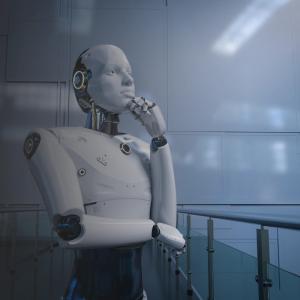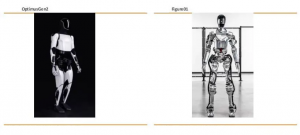Robot Revolution: AI and New Materials Usher in the Year of Industrialization
Robot Revolution: AI and New Materials Usher in the Year of Industrialization
JINHUA, ZHEJIANG, CHINA, June 17, 2024 /EINPresswire.com/ -- since last year, the rapid development of AI large models has continuously propelled advancements in humanoid robot technology. In December 2023, Tesla unveiled the humanoid robot OptimusGen2. Compared to the first generation, the second generation Optimus features a two-degree-of-freedom neck, a 30% increase in walking speed, a 10 kg weight reduction, and a new 11-degree-of-freedom hand, among other highlights in perception, motion, and control.In March 2024, Figure, a leading American robotics startup, launched Figure01, the world's first robot powered by an OpenAI large model. Utilizing OpenAI, Figure01 can engage in end-to-end neural network-based conversations and interactions with humans without any remote operation. During these interactions, the OpenAI model provides advanced visual and language intelligence, while graphical neural networks enable swift, precise, and agile robot movements.
Humanoid robots have broad application fields, and their market scale is rapidly expanding. The downstream applications of humanoid robots cover a wide range of sectors, including construction, education, entertainment, healthcare, and aerospace. According to Markets and Markets, the global humanoid robot market size was $1.8 billion in 2023, and it is expected to reach $13.8 billion by 2028, with a compound annual growth rate (CAGR) of 50.2%. By category, the education and entertainment sectors are expected to see the fastest growth, while the healthcare sector will hold the largest market share. Geographically, the market shares in North America, Europe, and the Asia-Pacific region are projected to be approximately 34%, 29%, and 34%, respectively, accounting for 98% in total. In terms of supply, Japan and China are set to become major hubs for humanoid robot manufacturing.
As mass production approaches, reduced costs may significantly expand the market size. Elon Musk stated that the final price of the Optimus humanoid robot could be less than $20,000, with mass production expected within 3-5 years. Once the humanoid robot industry chain matures, future production volumes could reach 100-200 billion units, far exceeding the Earth's population several times over.
Carbon Fiber and PEEK: Core Materials for Lightweight Robots
The weight of humanoid robots must be strictly controlled. If the weight is too high, it will increase the torque burden on the servomotors, making it difficult to meet the requirements for driving the robots. Lightweight robots can greatly improve mobility and work efficiency, thereby enhancing operating speed and accuracy while reducing motion inertia and improving inherent safety. Robotics companies, while meeting high-speed and high-precision performance requirements, reduce the robots' weight through lightweight technology, which not only enhances overall performance but also reduces energy consumption and environmental pollution. Lightweight structural materials for robots must meet the following requirements:
High Strength: In industrial production, robot structural materials must ensure a certain level of strength to prevent safety accidents and extend the robots' service life.
High Elastic Modulus and Elastic Limit: Robots need to withstand external forces during operation, requiring materials that can resist elastic deformation and avoid plastic deformation, which is essential for precise control.
High Vibration Damping: Robot components experience local stress and vibration due to inertia during start and stop. For precise positioning and stable transmission, the material must absorb these vibrations.
Lightweight: Lightweight materials reduce energy consumption, lower motion inertia, and reduce the load on components, especially in special environments like aerospace, where minimizing weight is crucial.
2.1 Carbon Fiber: Enhancing Robot Safety and Efficiency
Advanced composite materials outperform metals. Compared to traditional metal materials like aluminum alloys, modern composites like carbon fiber provide high-performance solutions for producing lightweight and strong robot components. Carbon fiber's combination of light weight and strength makes it crucial for the future development of humanoid robots.
In the domestic market, robotic arms are often made from steel, iron, and aluminum alloys, which suffer from drawbacks such as slow speed, high energy consumption, and susceptibility to deformation and wear. In contrast, carbon fiber reinforced materials offer several advantages:
Lightweight and Low Energy Consumption: Carbon fiber composites have a density only one-third that of steel and are 30% lighter than aluminum alloys.
High Strength and Load Capacity: Carbon fiber composites have higher specific strength, specific modulus, and tensile strength than steel, with specific strength being 43 times that of steel materials.
Low Creep and High Precision: Carbon fiber composites have an extremely low thermal expansion coefficient and minimal creep, allowing them to perform well in environments with large temperature variations.
Durability and Wear Resistance: Carbon fiber composites exhibit excellent fatigue and wear resistance, reducing maintenance and replacement frequency.
The development of carbon fiber robotic arms involves stages such as technical research, small-scale trials, pilot production, and industrialization, including process optimization, safety testing, quality inspection, and disposal of scrapped products. Due to their superior properties, carbon fiber composites are a research focus in the robotics field. For example, EksoBionic's Ekso exoskeleton system and Panasonic's wearable robot "AssistSuite" use carbon fiber composites for their key components.
2.2 Polyether Ether Ketone (PEEK): Superior Performance for High-End Applications
Polyether ether ketone (PEEK) is a high-performance engineering plastic with excellent properties such as high-temperature resistance, wear resistance, corrosion resistance, and self-lubrication. It is suitable for humanoid robots, new energy vehicles, medical devices, and other fields requiring lightweight materials. In December 2023, Tesla's Optimus-Gen2 garnered attention for successfully using PEEK, reducing the robot's weight by 10 kg and increasing walking speed by 30%.
PEEK offers significant performance advantages over other plastics. It surpasses most specialty engineering plastics in rigidity while also exhibiting toughness and comprehensive mechanical properties. PEEK also excels in heat resistance, wear resistance, and corrosion resistance, making it one of the best-performing thermoplastic materials globally.
Under the trends of "replacing steel with plastics" and "lightweighting," PEEK is increasingly replacing metal materials in high-end applications. As a high-strength polymer material, PEEK can significantly reduce weight while meeting strength requirements, providing a solution for achieving "lightweighting." Additionally, PEEK's superior insulation and chemical resistance make it a favorable alternative to metals, enhancing the durability and performance of humanoid robots.
+1 386-896-6491
sales@peekmaterials.com
zhejiang bw industry company
BW PEEK
Legal Disclaimer:
EIN Presswire provides this news content "as is" without warranty of any kind. We do not accept any responsibility or liability for the accuracy, content, images, videos, licenses, completeness, legality, or reliability of the information contained in this article. If you have any complaints or copyright issues related to this article, kindly contact the author above.


